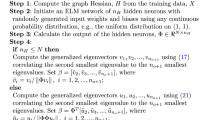Abstract
Extreme learning machine (ELM) has become one of the new research hotspots in the field of pattern recognition and machine learning. However, the existing extreme learning machine algorithms cannot better use identification information of data. Aiming at solving this problem, we propose a regularized extreme learning machine (algorithm) based on discriminative information (called IELM). In order to evaluate and verify the effectiveness of the proposed method, experiments use widely used image data sets. The comparative experimental results show that the proposed algorithm in the paper can significantly improve the classification performance and generalization ability of ELM.







Similar content being viewed by others
References
Belkin M, Niyogi P (2003) Laplacian eigenmaps for dimensionality reduction and data representation. Neural Comput 15(6):1373–1396
Benoit F, Miche Y, Verleysen M (2013) Feature selection for nonlinear models with extreme learning machines. Neurocomputing 102:111–124
Deng W, Chen R, He B, Liu YQ, Yin LF, Guo JH (2012) A novel two-stage hybrid swarm intelligence optimization algorithm and application. Soft Comput 16(10):1707–1722
Feng G, Huang GB, Lin Q (2009) Error minimized extreme learning machine with growth of hidden nodes and incremental learning. IEEE Trans Neural Netw 20(8):1352–1357
Fu ZJ, Sun XM, Liu Q, Zhou L (2015) Achieving efficient cloud search services: multi-keyword ranked search over encrypted cloud data supporting parallel computing. IEICE Trans Commun E98–B(1):190–200
Gu B, Sheng Victor S, Romano W, Li S (2015a) Incremental support vector learning for ordinal regression. IEEE Trans Neural Netw Learn Syst 26(7):1403–1416
Gu B, Sheng Victor S, Wang ZJ, Ho D, Osman S, Li S (2015b) Incremental learning for \(\nu \)-support vector regression. Neural Netw 67:140–150
Gu B, Sun XM, Sheng Victor S (2016) Structural minimax probability machine. IEEE Trans Neural Netw Learn Syst. doi:10.1109/TNNLS.2016.2544779
Huang GB (2014) An insight into extreme learning machines: random neurons, random features and kernels. Cogn Comput 6:376–390
Huang G, Song SJ (2014) Semi-supervised and unsupervised extreme learning machines. IEEE Trans Cybern 44(12):2405–2417
Huang GB, Song JS, You KY (2015) Trends in extreme learning machines: a review. Neural Netw 61:32–48
Huang GB, Zhou HM, Ding XJ, Zhang R (2012) Extreme learning machine for regression and multiclass classification. IEEE Trans Syst Man Cybern B Cybern 42(2):513–529
Huang GB, Zhu QY, Siew CK (2006) Extreme learning machine: theory and applications. Neurocomputing 70(1):489–501
Iosifidis A, Tefas A (2013) Minimum class variance extreme learning machine for human action recognition. IEEE Trans Circuits Syst Video Technol 23(11):1968–1979
Karimi J, Nobahari H, Pourtakdoust SH (2012) A new hybrid approach for dynamic continuous optimization problems. Appl Soft Comput 12(3):1158–1167
Kasun LLC, Huang GB, Zhou HM (2013) Representational learning with ELMs for big data. IEEE Intell Syst 28(5):31–34
Li HF, Jiang T, Zhang KS (2006) Efficient and robust feature extraction by maximum margin criterion. IEEE Trans Neural Netw 17(1):157–165
Liang NY, Huang GB, Saratchandran P, Sundararajan N (2006) A fast and accurate online sequential learning algorithm for feedforward networks. IEEE Trans Neural Netw 17(6):1411–1423
Liu SL, Feng L, Xiao Y (2014) Robust activation function and its application: semi-supervised kernel extreme learning method. Neurocomputing 144:318–328
Liu XY, Gao CH, Li P (2012) A comparative analysis of support vector machines and extreme learning machines. Neural Netw 33:58–66
Liu Q, Zhou S, Zhu C, Liu X, Yin J (2016) MI-ELM: highly efficient multi-instance learning based on hierarchical extreme learning machine. Neurocomputing 173(3):1044–1053
Luo JH, Vong CM, Wong PK (2014) Sparse bayesian extreme learning machine for multi-classification. IEEE Trans Neural Netw Learn Syst 25(4):836–843
Man ZH, Wang DH, Cao ZW, Khoo SY (2012) Robust single-hidden layer feedforward network-based pattern classifier. IEEE Trans Neural Netw Learn Syst 23(12):1974–1986
Miche Y, Sorjamaa A (2010) OP-ELM: optimally pruned extreme learning machine. IEEE Trans Neural Netw 21(1):158–162
Peng Y, Lu BL (2015) Discriminative graph regularized extreme learning machine and its application to face recognition. Neurocomputing 149:340–353
Rong HJ, Huang GB, Sundararajan N, Saratchandran P (2009) Online sequential fuzzy extreme learning machine for function approximation and classification problems. IEEE Trans Syst Man Cybern B Cybern 39(4):1067–1072
Tang J, Deng C, Huang GB (2015) Extreme learning machine for multilayer perception. IEEE Trans Neural Netw Learn Syst 99:1–13
Wen XZ, Shao L, Xue Y, Fang W (2015) A rapid learning algorithm for vehicle classification. Inf Sci 295(1):395–406
Xia ZH, Wang XH, Sun XM, Liu QS, Xiong NX (2016) Stege analysis of LSB matching using differences between nonadjacent pixels. Multimed Tools Appl 75(4):1947–1962
Yang YM, Wang YN, Yuan XF (2012) Bidirectional extreme learning machine for regression problem and its learning effectiveness. IEEE Trans Neural Netw Learn Syst 23(9):1498–1505
Yu Q, Miche Y, Eirola E, van Heeswijk M, Severin E, Lendasse A (2013) Regularized extreme learning machine for regression with missing data. Neurocomputing 102:45–51
Zhao JW, Wang ZH, Park DS (2012) Online sequential extreme learning machine with forgetting mechanism. Neurocomputing 87:79–89
Zhu HY, Wang YG (2013) A modified extreme learning machine with sigmoidal activation functions. Neural Comput Appl 22(3–4):541–550
Zong WW, Huang GB, Chen Y (2013) Weighted extreme learning machine for imbalance learning. Neurocomputing 101:229–242
Acknowledgments
This study was funded by National Natural Science Foundation of China (Grant Number 61105085) and Science Foundation of education ministry of Liaoning province (L2014427).
Author information
Authors and Affiliations
Corresponding author
Ethics declarations
Conflict of interest
Author Deqin Yan declares that he has no conflict of interest. Author Yonghe Chu declares that he has no conflict of interest. Author Haiying Zhang declares that she has no conflict of interest. Author Deshan Liu declares that he has no conflict of interest.
Ethical standard
All procedures performed in studies involving human participants were in accordance with the ethical standards of the institutional and/or national research committee and with the 1964 Helsinki Declaration and its later amendments or comparable ethical standards.
Human and animal rights
All applicable international, national, or institutional guidelines for the care and use of animals were followed.
Informed consent
Informed consent was obtained from all individual participants included in the study.
Additional information
Communicated by V. Loia.
Rights and permissions
About this article
Cite this article
Yan, D., Chu, Y., Zhang, H. et al. Information discriminative extreme learning machine. Soft Comput 22, 677–689 (2018). https://doi.org/10.1007/s00500-016-2372-y
Published:
Issue Date:
DOI: https://doi.org/10.1007/s00500-016-2372-y




